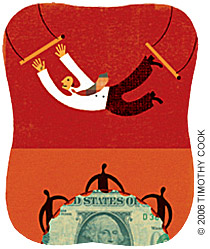
This physician is expanding his cash-only practice to keep up with demand.
Fam Pract Manag. 2006;13(2):64

In 2002, Brian Forrest, MD, left salaried practice to test a hypothesis: that a practice with no ties to health plans could operate with low overhead, charge low fees that could be successfully collected at the time of service, improve access for uninsured patients who have limited resources, and attract enough patients to produce a good income for the providers. The results of his experiment have far exceeded his expectations. Last year, just three years after opening Access Healthcare in Apex, N.C., Forrest had to close the practice to new patients. Later in the year he hired a nurse practitioner, whose practice is on pace to be full within six months of her start date. Forrest's income is above the average for family physicians. His work hours are not. And he's finalizing plans to open a second location later this year.
Decreasing overhead is the key to making the practice viable, Forrest says. He saved enough money in nine months prior to opening his practice to cover his start-up expenses, including the down payment for the building in which the practice is located, and pay his overhead for the first year. The start-up expenses were $10,000, mainly for equipment, supplies and injectables, Forrest says. He maintains a 1:1 ratio of staff to providers, and operating costs have also been reduced. His overhead has stabilized at 25 percent, less than half that of a traditional practice. This enables him to charge a fee for office visits that's not much more than some health plan's co-pays, see fewer patients than in a traditional practice (he limits visits to 16 a day) and still net a higher reimbursement per encounter than most, at $56 on average.
Forrest's practice charges a flat fee of $45 for office visits. “Whether the visit is 15 minutes or an hour, the fee is the same,” he says. The average office visit is 30 minutes. The practice charges patients separately for lab tests, and the practice pays the lab. Because the labs avoid the expenses of billing patients or insurance companies, they offer discounts from 50 percent to 90 percent, which Forrest passes along to his patients. For example, a prostate-specific antigen test costs $25, he says. The average patient pays about $30 for lab services in addition to the office visit fee. The practice collects 99.98 percent of charges, with almost all of the uncollected amounts in bounced checks, he says. All payments are collected at the time of service; no billing is required.
Forrest emphasizes that he is not providing concierge care. His diverse panel of 2,500 patients, roughly 30 percent of whom have no insurance, is evidence of that. Another 50 percent have traditional insurance, and 20 percent have high-deductible or hospital-only coverage. Forrest opted out of Medicare, and most of the patients who have commercial insurance submit their own claims and get reimbursed on an out-of-network basis. His uninsured patients are happy to pay fees that are far less than what others charge.
“If patient demand is any indication, patients really like this model of care,” Forrest says. The practice averages 15 new patients a week, with word of mouth from satisfied patients producing the biggest referral stream, and attrition has been very low. Forrest says patients appreciate the amount of attention he's able to provide. “Instead of waiting 50 minutes for a five-minute exam, they wait five minutes and may spend 50 minutes with me in the exam room,” he says. “They really value that.”